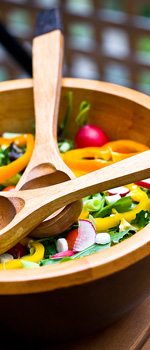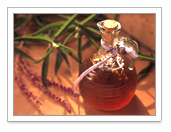
|
Follow Me On: |
 |
Kathleen Petty AVP/Sr Mortgage Originator Global Credit Union Home Loans AK#157293 Phone: (907)261-3458 Cell: 223-4440 Fax: (907)929-6699 License: NMLS Unique Identifier #203077 K.Petty@gcuhome.com https://www.globalcu.org/home-loans/resources/originators/Kathleen-Petty/ |
 | ||
| ||||
April 2008

|
Vim and Vinegar Bringing Vitality to Your Food with an Age-Old Ingredient by Kirk Leins
Vinegar is one of the world's original processed foods. For more than five thousand years, food lovers worldwide have been using this incredible ingredient to breathe life into a variety of dishes. But the allure of vinegar doesn't end there. Follow me as I explore one of the most interesting and complex products found in any supermarket, in every city throughout the world. The History of Vinegar Most historians are fairly certain that the birth of vinegar was the result of not one, but two separate accidents. Accident number one occurred when grape juice was left undisturbed, long enough for the sugars to ferment and for the juice to transform into wine. That accident quickly turned into a celebration. Accident number two was the result of the wine being left undisturbed. When wine (or any alcoholic beverage less than 18 percent alcohol) sits untouched, airborne bacteria known as acetobacter aceti turn it into an acid. Any spirits with an alcohol percentage higher than 18 percent need to be diluted or the alcohol will kill the acetobacter. Throughout the centuries, vinegar's stock continued to rise, as many civilizations around the world caught on to its versatility. But it was during the 200 or so years in between the late 14th and 16th centuries when a very important vinegar-making method was discovered and perfected in France. Known as the Orleans method (named after the city of Orleans), wine or cider is mixed with "Mother of Vinegar," a slimy glob of cellulose and bacteria that is created during open-air vinegar-making process. The mixture is then placed into wooden barrels and allowed to ferment for several months. Most of the completed vinegar is then drawn off. More alcohol is added to the remaining vinegar and "mother," and the process starts over. The Orleans method not only sped up production, it resulted in milder, and far more complex tasting vinegar. While much of the vinegar we buy in the market nowadays is made in industrialized tanks that accelerate the process even more, artisan vinegar makers still utilize the Orleans method. Another difference between mass-produced and artisan vinegar is pasteurization. Since the acid within the vinegar kills off the vast majority of harmful bacteria, it is not exactly necessary to pasteurize it. The real purpose of pasteurization is to prevent the formation of "mother" after it's been bottled, something most consumers would probably consider unappetizing. So now that we have an understanding of what vinegar is as well as how it is made, it's important to know that there are many different types, most of which are inherent to a country or region, and each are used with specific foods. And while it would be fun to talk about all of them, doing so would turn this article into a dissertation. For now, let's take a look at one of my favorite vinegars. Balsamic Vinegar For anyone unfamiliar with Jeff's company, I'd suggest reading my September '07 article, Olive Oil: The Culinary World's Most Important Commodity . For now, just know that Jeff imports and sells some of the finest artisan olive oil Italy has to offer. Lucky for us, Olio2go.com also sells vinegar. Jeff says, "According to Italian law, true balsamic vinegar, Aceto Balsamic Tradizionale may only come from two provinces, Modena and Reggio Emilia, of the Emilia Romagna region." From the first literary reference in 1046, through the next eight centuries, balsamic production within these areas utilized wine made from the Trebbiano grape. But In 1861 an Italian lawyer named Francesco Aggazzotti revolutionized the industry. Instead of wine, Aggazzotti suggested the use of grape must, a concentrated version of unfermented grape juice. The must was then heated in copper kettles and allowed to reduce until thick and viscous. The must ferments over many years as it is transferred through several types of wooden barrels – oak, ash, mulberry, cherry and chestnut. As the vinegar continues to age its flavors concentrate and become multidimensional. Italian legend says the portion of the liquid that evaporates is considered "the angels' share." Vinegar tagged as Tradizionale is aged a minimum of 12 years and up to 100. Anything aged over 25 years receives the special designation of extravecchio. Chandler says that because of the intense process, Tradizionale vinegar is on the pricier side and therefore used, "by the drop." It is never heated directly and only used to provide a finishing accent on really special dishes. Sweet, slightly acidic, rich and syrupy are some of the words Jeff uses to describe Aceto Balsamic Tradizionale. The next grade down (if you can call it that) is something known as aceto balsamico. Still adhering to the strict standards of the balsamic vinegar consortium, aceto balsamico is aged a minimum of six years. While the quality is still great, it is generally not at the level as vinegar deemed Tradizionale. The good news here is that prices are lower, allowing the average consumer to use aceto balsamico in larger amounts. According to Chandler, any vinegar "produced outside the sanctions of the consortiums" and marketed in its own packaging is officially labeled condimento, or condiment. In other words, if you don't follow the rules you cannot call it balsamic vinegar. I love Italians. It came time for Jeff to do what he does best – pick out a couple of great vinegars for me to cook with. I told him that I was interested in two different types. I wanted one of the vinegars to be an aceto balsamico, something that most everyone could not only afford, but also use in a variety of dishes. My second request was for something really special, a tradizionale of some kind. My hope was to create a mind-blowing dish. Here is what the two of us came up with: Vinegar Pick: Manicardi #12 Jeff's recommendations for Manicardi #12 are as a light dressing (along with extra-virgin olive oil) over field greens, a drizzle for any steamed vegetable or roasted meat, a condiment for omelets and risottos, and a tangy dip for slices of Parmigiano-Reggiano. I went a slightly different route and created a recipe for a satisfying entree. Enjoy! CHICKEN BALSAMICO with AU JUS (Serves 3 to 4)
In a bowl, combine ¼ cup balsamic vinegar, olive oil, garlic, 1 tbsp lemon zest and salt and pepper. Place chicken into a large, re-sealable plastic bag and pour in the marinade. Seal the bag and allow chicken to marinate in the refrigerator for 2 to 24 hours. Remove chicken from the bag and pat dry with paper towels. Liberally season with salt and pepper and place in a greased roasting pan. Roast in a preheated, 400-degree oven for 40 minutes, or until the internal temperature of the chicken breasts reach 160 degrees and the thighs reach 175 degrees. Transfer chicken to a serving platter and loosely tent with foil. Place the roasting pan over two burners set to a medium heat. Add the chicken stock and remaining tablespoon of Manicardi #12 balsamic vinegar. Allow the mixture to come to a simmer. Using a wooden, spoon scrape up any of the caramelized juices that have accumulated on the bottom of the pan. After the liquid has slightly reduced, taste and re-season with salt and pepper if necessary. Skim off any excess fat and pour over the plated chicken. Garnish the chicken with the remaining lemon zest and parsley. Serve with a good quality extra-virgin olive oil and the bottle of Manicardi #12 on the side. Give the chicken a small drizzle of each before eating. This meal screams for side dishes of roasted new potatoes with rosemary, and wilted baby spinach with garlic and olive oil. Vinegar Pick: Aceto Balsamic Tradizionale di Reggio Emilia (Red Seal) Retailing for $89.95 for a 100 ml (3.4-oz.) bottle, this vinegar was made at the Acetaia San Giacomo just outside Modena. With the consistency of thin syrup, the vinegar was sweet and pungent, carrying the haunting notes of the different wood barrels it had aged inside. Jeff recommends using this vinegar by the drop on Carpaccio or any rare meat, crudités, and Caprese salad. Personally, I think a few drops would add the perfect touch to a bowl of sliced strawberries or a dish of vanilla gelato. That's right; ice cream! When it came time to design a recipe for this delicious vinegar I put my thinkin' cap on. My goal was to create something elegant, yet understated enough to really show off the beauty of the Tradizionale. While I wanted to feature it along with a great piece of meat, I wanted to do it with something other than rare beef. Here's what I came up with. QUICK-BRINED PORK CHOPS with BALSAMIC DRIZZLE (serves 4)
In a large bowl, combine water, salt, brown sugar and molasses. Whisk until the salt and sugar are fully dissolved. Add garlic, peppercorns, juniper berries and bay leaves. Put pork chops into a large freezer bag and add the brine. Squeeze the air out of the bag and seal it. Place the bag in a baking dish to ensure against any leakage and refrigerate for 4 to 6 hours, turning every few hours. Preheat oven to 350 degrees Remove chops from the brine and pat dry with paper towels. Discard the brine. In a large skillet heat 2 or 3 tablespoons of olive oil until shimmering and very hot. Sear pork chops for 2 minutes on each side and transfer to a baking sheet. Roast chops in the oven for 8 minutes or until the internal temperature reaches 140 degrees. Plate the chops and allow them to rest for 3 to 4 minutes. Lightly drizzle the chops with the Tradizionale and serve. Trust me when I say you are going to love this dish. I served my pork chops with roasted sweet potatoes rubbed with olive oil and dried sage, and shredded red cabbage that I braised in vinegar along with sugar, apples and ground clove. It was fantastic! Now that our abridged course on vinegar has come to an end, I'm hoping you've learned a little about this magical and historic elixir. Just remember, if you are looking to bring a little vitality into your cooking, think vinegar. And if it's balsamic you're looking for, think www.olio2go.com. Tell the folks there that I sent you!
| ||||||||||||||||||||||||||||||
License #AK157293 You are receiving a complimentary subscription to YOU Magazine as a result of your ongoing business relationship with Kathleen Petty. While beneficial to a wide audience, this information is also commercial in nature and it may contain advertising materials. INVITE A FRIEND to receive YOU Magazine. Please feel free to invite your friends and colleagues to subscribe. SUBSCRIBE to YOU Magazine. If you received this message from a friend, you can subscribe online. UNSUBSCRIBE: If you would like to stop receiving emails from Kathleen Petty, you can easily unsubscribe. Global Credit Union Home Loans AK#157293 |
, 125 W Dimond Blvd #110 Anchorage, AK 99515 Powered by Platinum Marketing © Copyright 2024. Vantage Production, LLC. | |||||||||



 Kirk Leins has been cooking his entire life. No stranger to professional kitchens, he currently devotes most of his time to cooking instruction, food writing, and producing television. Kirk also provides his services as a personal chef in and around the Los Angeles area. He has made several TV appearances on both the national and local level, and is the Executive Chef for YOU Magazine. His free newsletter, The Everyday Gourmet, is available by contacting Kirk at
Kirk Leins has been cooking his entire life. No stranger to professional kitchens, he currently devotes most of his time to cooking instruction, food writing, and producing television. Kirk also provides his services as a personal chef in and around the Los Angeles area. He has made several TV appearances on both the national and local level, and is the Executive Chef for YOU Magazine. His free newsletter, The Everyday Gourmet, is available by contacting Kirk at